Shipped since July 2019, the unit has upgraded the transformers ,
can power on long term.
Operate guide:
The product through the USB A-B cable connect
Mac computer.
In the Mac OS audio control panel,
select the soundcard device that name " Amanero" as the default
output soundcard .
The product output ports connect to
the active speaker , play music in Mac OS, like iTune, the product
will decode the data from USB and output to the active speaker.
Please note:
The product even had burn in over 300 hours before shipping.
You can power on it with playing music if you are at home for
quickly finished burn in. If you don't want listen music during the
burn in term, you can turn the amp volume to minimum.
Please power off before connect or
disconnect the inputs and outputs .
Power on the product must had more
than the half minute after last power off .
Function introduce (Shipped Since 10th June 2019 ):
The DAC can setting the digital
process functions on front plate to change the sound flavors, without open the unit .
Since 20th. Mar. 2019 the
unit built in tda_asy firmware. The older V3 firmware function
introduce please click to read it
R7_V3 firmwares function
introduce.
Before 10th June
R7HE with tda
firmware introduce
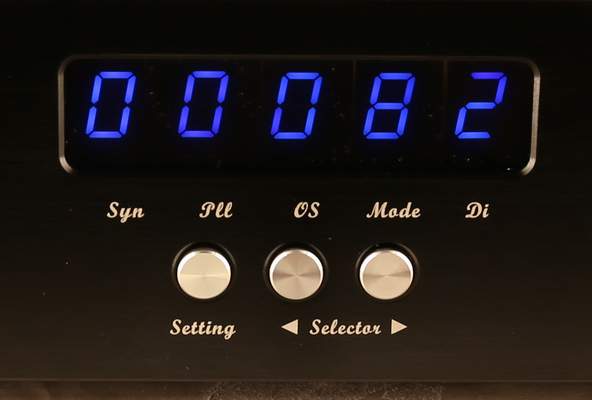
Important warn:
Before push the
"Setting" button,
I are advice user turn low the amp volume, stop the
music track playing .
Because for
the aim to reproduce the best sound quality, the DAC without mute design , change the
setting may output circuit switch sound .
Around 5 seconds after non
any button had push, the display stop blink, user
can click the music track to playing and turn up the volume.
Setting button :
Push the
"Setting" button one
time, the one digit display will blink for active the function
setting , push the right "Selector" button can change function . While
the display blink, push "Setting" again , the right next
one digit display
will blink , push the left "Selector" button the left next one digit
display will blink .
While the "Dis" LED blink, push
the "Setting" one time , the menu will change to menu page 2.
Left Selector buttons:
While
the display non blink, for select the input sources.
While the display blink,
for the setting digit move one left.
Right Selector buttons:
While
the display non blink, for select the input sources.
While the display blink, for
setting the digital process functions.
Menu Page 1:
Syn (non function in the Asy
version) :
For the Syn version if the HDMI input had noise, distortion or some
samplings no sound, user can setting the 1st number ON (1) or OFF
(0) to fixed the issue. In default is OFF (0) .
Pll
(Simulate SAA7220 +TDA1541A sound) :
Active
(1) : Simulate SAA7220 +TDA1541A, digital attenuation low to -55DB,
was -130DB. Bitwide low to 16bit , was 24 bit. While active this
function, I are advice setting to OS2 or OS4 mode. But infact, this
function can working with any setting mode.
OS (Oversampling) :
"O" for select oversampling,
"N" for select NOS mode.
Mode ( OS and NOS modes):
While OS
setting on "O" mean the DAC working under oversampling
mode, loIr number OS modes sound became warmer
and smoother. Or depend on your sense .
Mode "0" : class
technology NOS mode.
Mode "2" : 2X oversampling.
Mode "4" : 4X oversampling .
Mode "8" : 8X oversampling.
While OS setting on "N" mean
the DAC working under NOS mode, it has one mode now, it is the full
new NOS configure design.
Di (Display) :
Active (1) the display
auto dark, the display will become dark in around 10 seconds after
stop operate any buttons . Disable (0) the display auto dark, the display light
always.
Menu Page 2:
1st number (Dither) :
Active
(1) or Disable (0) dither for all inputs.
2nd
number (non function in the Asy version) :
For the Syn version if user want to replace other brands USB module
in the unit, user can setting the 2nd number ON (1) or OFF (0) to
find the best match .In default is OFF (0) .
HDMI
definitions : (Compatible with PS audio standard)
Pin 1 : SDATA -
Pin 2 : GND
Pin 3 : SDATA +
Pin 4 : SCLK +
Pin 5 : GND
Pin 6 : SCLK -
Pin 7 : LRCK -
Pin 8 : GND
Pin 9 : LRCK +
Pin 10: NC (Syn
version still need the Mclk+ on this pin)
Pin 11: GND
Pin 12: NC (Syn
version still need the Mclk- on this pin)
Pin 13: NC
Pin 14: NC
Pin 15: NC
Pin 16: NC
Pin 17: GND
Pin 18: NC
Pin 19: NC
R7_tda_Asy don't need MLCK input . Even the
source has MLCK output but has not effect .
R7_tda_Asy and
R7_tda_Syn
firmwares
(NOS mode Support up
to 768K)
What's the different between R7_tda_Asy and
R7_tda_Syn:
R7_tda_Asy is the firmware running in
asynchronous mode, after update it can without input the Mclk signal
from HDMI-IIS input, regenerative inside by the Accusilicon clocks.
R7_tda_Syn is the firmware running in
synchronous mode, it still need the Mclk signal from HDMI-IIS
input.
Some users may don't concern the
technology different, they just concern the sound and they know the
technology advantage don't mean the sound better .
In the simple, you can consider R7_tda_Asy
is the Accurate version and the R7_tda_Syn is the
Smooth version.
Update guide:
R7 update
guide
Upgrade Port :
The DAC can through an USB cable
connect betIen computer and "Upgrade Port" to upgrade the firmware
for improve the sound quality or performance .
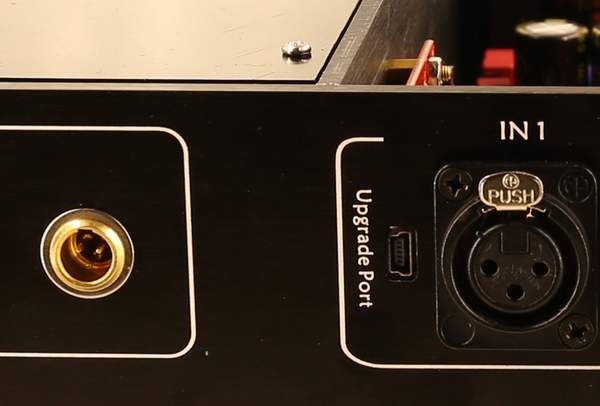
|
In Oct. of 2015 year, I
wanted to update the FPGA firmware for the products. That time I did not
know the FPGA program design.
I asked some professional friends
, give them the function request same as our older Master 7 V7
firmware , they confirm they can do it but no one could give me a promise on
sound quality, even though they asked a quite expensive price, around
USD15000 .
I was sad, then became powerful ,
I decided to study the FPGA programming.
I went to school every Sat. and Sun.
for a half of year .
After I finished the course, even
though I worked hard to study every day and night in those months,
but I feel I could
not to do anything on the project, I was feel I waste that 6 months .
How many 6 months in a people life? If you never had the similar
experience ,you may can not understand my feel in
that moment.
But I have Never gave up.
I bought almost all books in the web
shops to studied the
digital signal process and verilog language, I also searched on web to study anything
about the project.
You may can not image how difficult
of an old people to study , finally, in Oct. 2016, I finished the
first project ,that was the Master 7 V7 firmware .
Some users updated the firmware and gave
me the positive feedback , that helped me continued study .
Few months ago, I got the Accusilicon
clocks samples, its ultra specs let me considered design a firmware to
let the DAC working on fully asynchronous mode, previous was working
on hybrid mode.
I spent a lot time to listen and
compare the sound between asynchronous , synchronous and hybrid modes, finally I finished the new firmware, it offer the best
neutral and transparency compare to the other versions but
most lively sound. Every detail in sound is so neutral without feel
fake. I also finished the synchronous firmware offer another sound
flavor.
In the asychronous design, it don't need the
input MCLK signal . I have applied the 98.304MHz and
90.316MHz clocks, that has enough high frequency allow the clock
signal regenerative direct from the clocks but not through the PLL
frequency multiplication output.
The PLL output signal has large
jitter compare to the Accusilicon clocks.
The high end sources can do very well
and very low jitter on the output digital signal, but in audio
field, the both RJ45 or HDMI are not the professional transmit
methods, even the source output the perfect signal, during transmit, the
different frequency signal had different delay and interrupt cause the signal
became worse while feed into the DAC.
I designed an input signal
corrector to get the signal , in phase process the signal and clock
to perfect state for avoid the signal degrade during transmit.
The regenerative clock is from
the Accusilicon clocks, it has ultra good performance.
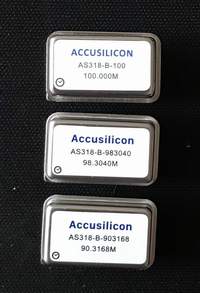
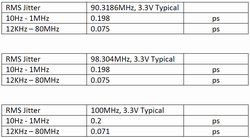
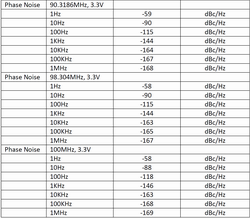
I also applied the new
function to simulate the sound of SAA7220 +TDA 1541A.
You can setting the PLL
function to 1, but now it don't mean the PLL anymore, it mean the DAC
running simulate SAA7220+ TDA1541A configure .
I also designed the new
configure NOS mode . The mode support up to 768K sampling input with
test.
I have some lot red book discs
and a lot time listen with the CD transport, in this firmware, I
have done some significative upgrade for the SPDIF input .
Every codes is not only based
on technology but through a lot time to audition to confirm .
After you update this firmware,
the HDMI input can without MCLK signal. The MCLK is much higher
frequency signal than the IIS signal, so it had more sensitivity to
the interrupt than the IIS signal. The DAC not depend on
MCLK input anymore, the sound quality get more promise.
Even the R 7 had not
applied Accusilicon clocks but it still can update these firmwares
and improve on sound quality .
Different people may has
personal listen taste , I can not promise you like this version
sound .
This version firmware had
not emphasize on detail or transparency, every thing just most neutral and
lively .
Give me your feedback to help
me improve the firmwares. |
|
|


